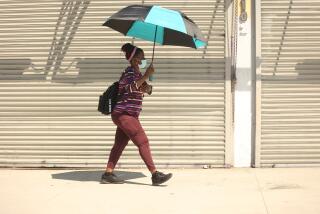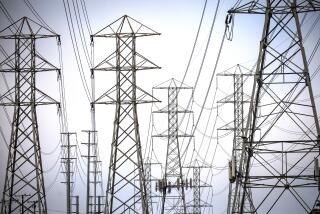Some Simple Things to Do to Keep Your Cool in Case of a Heat Attack
- Share via
Living in Orange County, we don’t experience the oppressive, sticky summer heat waves our friends and relatives in the East and Midwest have to endure, but we do face streaks of unbearably hot weather. Air conditioning is the best way to get through a miserable summer, but if you don’t have it or don’t want to use it because you fear large electric bills, there are other ways to keep cool.
You may have already made some simple changes in your lifestyle to live with summer. Cooking on an outdoor grill keeps the kitchen cool. When you have to use the stove, turn on the vent fan above it to help get rid of some of the heat.
Open doors and windows in the early morning hours and place a fan near one of them to circulate the cool air.
Other methods of cooling may mean making some changes in your home.
The sun’s rays are the biggest reason your home heats up during the day. Light pours in through the windows and warms up the air inside. If you’re able to restrict some of that light from entering, you can keep the interior air from warming.
Closing drapes and shades is a simple, though not very aesthetic solution, or you can apply reflective tinting film to windows that face the sun. The film, available at most hardware stores, also cuts down on glare.
If your windows are old and you’re considering replacing them, you might want to take a look at double-glazed windows. These have been popular in areas where there are more extremes in climate, and while usually thought of in terms of their ability to seal out the cold, they’re also effective in keeping out the heat.
“They’re basically made with two panes of glass that leave a dead air space in between,” says Hand Uribe of Buena Park Glass & Mirror. “They can save you up to 30% in heating and cooling costs, since they’re more efficient than a single pane of glass.”
Although they’re not as popular as they were a few decades ago, awnings over windows are extremely efficient at keeping direct sun from heating your house. If you’re considering them, look for the type that can be removed or lowered in winter, when you want the sun to come through the windows and heat things up.
There’s another reason your house gets hot that you may never have thought of, but it’s right over your head--the attic space.
“When the sun beats down on the roof all day, that heat transfers into the attic and if the attic isn’t well insulated, it’s going to flow right into the house,” says insulation expert Steve Kramer of Fullerton. “You might try a thicker insulation, like an R-30, which would give you year-round protection.”
You might also consider getting rid of that hot air in the attic. This can be done with ventilators, which allow the hot air to escape through the roof. It’s suggested that you use one ventilator for every 150 to 250 square feet of attic space. Ventilators can be as simple as a metallic grate or louvers from which air can pass, or they can be electric-powered fans that drive out the hot air.
Whole house ventilators are a less expensive and a more energy-efficient alternative to an air conditioner. “These work by taking cooler air from inside the house and blowing it into the attic,” says Gordon Graham of Graham Brothers Heating & Air Conditioning in Costa Mesa. “This creates circulation inside your house and keeps hot air in the attic from collecting and heating the living areas below.”
Rod Albright of Albright Plumbing & Heating Supplies in Los Alamitos says: “It’s best to install these ventilators in a central location in the house. That way, you’re able to pull as much air from all over the house as possible.”
While evaporative coolers are popular in Palm Springs and other desert areas as alternatives to air conditioning, the humidity we get during the summer makes them inefficient to use here. However, another common desert cooling device, the ceiling fan, is an excellent alternative to air conditioning.
Ceiling fans range from simple to high-tech in complex, and all work virtually the same way: Air is either forced down or pulled up, forcing the warmer air near the ceiling to be mixed with the cooler air below it.
“There are some fans that have a thermostat built in,” says Michael Hamburger of the Trading Post in Huntington Beach. “As the room’s temperature rises, the fan turns on and its speed climbs with temperature.”
Fans are also effective in winter, since they’re able to help circulate warm air created by the furnace. “People don’t often think about running their fans at that time, but they really can save on (electricity) bills. And should you decide to install air conditioning at some point, running the fan while the air conditioner is on will cool the house faster.”
It’s not easy getting away from the heat, but if you’re determined to stay cool, you can usually find ways to do it. Here are some other tips that might help you along.
* If your clothes dryer is inside your house, make sure the exhaust system is properly sealed and isn’t sending hot air into the house.
* Dark colors absorb heat, so if it’s time to repaint your house, consider lighter shades.
* Make sure the damper in the fireplace is closed, and check the sweeps at the bottoms of each door to see if they’re working.
* Evergreens and trees in yards shade the sun from getting inside your house.
* Make sure window screens are clean to allow a free flow of air inside and out.
* Light bulbs generate a great deal of heat. Use them only when necessary.
* Close the doors of rooms that aren’t being used.






